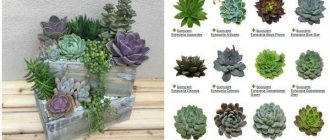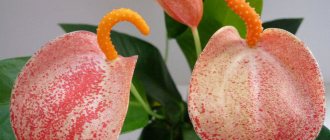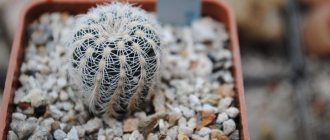Calla Zantedeschia Ethiopian description and cultivation features
Calla lilies description, photos of flowers, varieties for home and garden
Ethiopian calla zantedeschia
Calla aefiopica L.
or calla lily belongs to the Araceae family. Homeland: Africa.
This is a beautiful flowering plant that produces a first-class cut flower in industrial floriculture and blooms for a long time in rooms.
Pay attention to the photo - calla zantedeschia ethiopica has large, wide, arrow-shaped succulent leaves 60–80 cm long, on fleshy tender petioles:
The flowers of the Ethiopian Zantedeschia are original in their structure. The large flower arrow ends in a wide asymmetrical bell of white or yellow color. This “case” is surrounded by a narrow spadix, consisting of dense, inconspicuous flowers. The roots are cord-like and fleshy. They arise from a succulent tuberous rhizome, around which a large number of offspring with small, weak leaves develop throughout the year.
Look what a zantedeschia flower looks like in these photos:
Features of reproduction.
Calla lilies are propagated by seeds or suckers. Seedlings are grown throughout the year in ordinary bowls filled with crushed expanded clay and sand. The largest offspring are separated from the mother plant in June-July after flowering and planted in wide, low pots.
Features of cultivation.
Shade-tolerant and moisture-loving, prefers acidic, humus-rich soils. The pots are placed in wide pallets and kept on the northern and eastern windows. Callas bloom when they are two years old in the fall (November) and bloom all winter. When caring for calla zantedeschia at home, from the beginning of flowering, periodically give foliar feeding with microelements (boron, zinc, manganese, molybdenum, potassium iodide, copper) and often spray with clean water. After flowering, the leaves turn yellow and the growth of callas stops, although the roots continue to develop. During this period, all shoots are removed from the base of the bush, as they weaken the plant and delay flowering. Yellow leaves are cut out. After resting, callas develop powerful leaves and begin to bloom if the rules of care are followed. Calla lilies are planted in a mixture consisting of peat soil, clay-turf and humus soil with the addition of sand (1: 1: 1: 1/2). Calla grows great in clean peat.
In boxes it can be planted together with Kredner begonia and other ornamental plants. To care for the zantedeschia flower as carefully as possible, it is kept outdoors in the summer and brought indoors in the fall. During the period of leaf development, abundant watering and fertilizing are needed. In hydroculture it grows well for many years in gravel, expanded clay, peat, and various nutrient solutions at pH 5.0–6.0. The first days after planting the offspring, water is supplied to the substrate, then a nutrient solution of 50% concentration, and after 2–3 weeks - 100% concentration. The air temperature should be approximately +15–17 °C, humidity – 80–85%. At higher temperatures and lack of light, calla leaves stretch out, break easily, become light green in color, and the number of flowers decreases sharply.
Here are photos of caring for Zantede Ethiopian at home:
Calla lily is considered a true royal flower, symbolizing calm, respect and beauty. Caring for this plant at home is not difficult, but you should know some of its features so that the flowers do not get crushed and retain their brightness.
What to plant in?
You can start planting calla lilies as early as March. In nature, flowers grow in swampy areas, which must be taken into account when preparing the soil and choosing a flowerpot.
For one tuber you need a pot with a capacity of at least 3 liters, and the tray should be chosen deep enough (water should be in it constantly to create the required level of humidity).
It is better to take nutritious and slightly acidic soil for calla lilies. Flowers grow well in a clay-peat mixture (1:1) with the addition of one part of humus and half of sand.
Some gardeners also add a little river silt to the calla lily substrate.
Caring for calla lilies at home
Temperature:
How to propagate ficus at home - all possible ways
Room temperature is optimal for normal plant growth. In summer, you can take the calla lilies outside, protecting the plant from the scorching sun.
Humidity:
Air humidity is a fairly important criterion. At room temperatures above 20 degrees, calla lilies need to be sprayed.
Watering:
Proper watering is an important condition for good growth and development, so they need to be watered regularly and often. In order for a flower to grow well, it needs to be watered regularly and fertilizers must be added to the soil at least once a month.
The soil:
The calla flower feels good in slightly acidic soil, which you can prepare at home yourself. To do this you will need deciduous soil, peat and some sand. It is recommended to transplant adult flowers in late autumn, in November.
Bloom:
If you want to achieve year-round flowering, then the amount of fertilizing must be increased. However, you need to make sure that the flower does not receive too much. For example, a large amount of nitrogen in the soil negatively affects the leaves - they turn black around the edges. When flowering ends, the covers of the flowers turn green and droop, the leaves turn yellow and gradually dry out.
Reproduction:
Ethiopian calla reproduces by suckers and division of the rhizome. The offspring are separated from the mother plant and planted in pots. Water, spray and feed with nitrogenous fertilizers until buds appear, and during flowering - with fertilizers with a high content of phosphorus and potassium.
When dividing the rhizome, a bud must be present on each separated part. The cuts are treated with charcoal and each is planted in its own pot. There is no need to water until sprouts appear. After the sprouts appear, care is no different from caring for an adult plant.
“Colored” callas are propagated by tubers, which are simply separated from the mother plant. If the tubers do not separate easily, then there is no need to touch them. These tubers are not yet ready for independent life. It is better to leave them on the mother plant until they are old enough.
Complexity:
Ultimately, caring for calla lilies is not that difficult. It should be taken into account that care for different types of calla lilies varies. For example, white callas require more moisture, and their growth does not slow down during the period of dormancy and lack of flowering.
One of the most beautiful and wonderful flowers is calla lily. Thanks to its sophistication, it can be found not just at home, but as part of an expensive interior. Some consider calla lily to be a wedding flower, others are sure that it is a flower of death and have seen it at funerals. But still, the flower looks like a bride’s attire and is more considered a wedding dress. There are quite a few types of calla lilies; in this article we will talk about a separate type of Ethiopian calla lily.
Zantedeschia hybrids
"Memories"
The color of the bedspread of this calla lily is unusual, black with a burgundy tint, up to 12 cm in size. The inflorescence is the same, black and burgundy, as the bedspread. Plant height is from 45 to 50 cm.
"Nashville" (Nashville)
The shape of the perianth of this calla is elongated and narrowed, the color is two-tone: white and pink. The inflorescence is bright yellow. The size of the bedspread is 12 cm. The plant is compact, up to 45 cm tall.
"Picasso" (Picasso)
The flower is white at the edges, transitioning to a purple throat. The height of the peduncle is up to 15 cm, the spathe is 10 cm. The flowering time of one flower is up to 25 days. The dark green leaves have white spots that take on a metallic tint in the sun.
"Red Alert"
The height of the plant is up to 55 cm. The flower consists of a small bright red blanket and a red inflorescence. The blanket is elastic, shiny, like wax. The leaves are covered with frequent, white specks.
"Pink Mist"
This hybrid produces several flower stalks up to 35 cm long. The pale pink color of the bedspread with a bright orange inflorescence is unusual. The flowers are small, up to 10 cm.
How to care for a zantedeschia flower at home
Cereus cactus: popular plant species and caring for them at home
Difficulty of growing:
average.
Accommodation:
zantedeschia is a shade-tolerant plant, grown mainly in open ground, but also takes root well in indoor conditions. Indoors it can be placed both in a bright place and in a shaded one. It is best to place this plant on a window facing north or east.
In summer, Zantedeschias feel good in the garden, in the sliding shade of trees. When planted in open ground, powerful tubers grow and produce many children.
Lighting requirements:
bright diffused light with some direct sunlight (morning or evening).
Temperature Requirements:
optimal 22–23 °C. Tubers require a cool winter with a temperature of about 12 °C; you can store them in sawdust or slightly damp peat on the bottom shelf of the refrigerator. Before planting again, tubers need to be regularly removed and inspected, rotten parts must be cleaned, dried and treated with brilliant green.
Watering, spraying:
From spring to autumn, when caring for calla zantedeschia, it should be plentiful, and moderate in winter. For irrigation, it is advisable to use soft water at room temperature or warm. They respond positively to spraying and high humidity. You can keep the pot in a wide tray of water.
Feeding:
from February to June, when caring for Zantedeschia at home, every 10–14 days you need to feed the plant with a special fertilizer for flowering indoor plants. A high proportion of phosphorus in the fertilizer is the key to successful flowering. Nitrogen fertilizers (for decorative deciduous plants) will only stimulate leaf growth.
Transfer:
Every year, after a dormant period, the tubers are planted in fresh substrate, if possible without dividing. The larger the tuber, the more flowers it produces. Planting depth is 5 cm. Immediately after planting, zantedeschias form a root system and only then begin to grow green mass.
Substrate:
2 parts turf soil, 1 part compost or humus, 1 part leaf soil, 1 part peat and 1 part sand.
Reproduction.
Zantedeschia reproduces well by seeds or suckers. The offspring grow after flowering.
The suckers formed on the plant must be regularly removed, otherwise the flowering process will be disrupted.
Pests and diseases.
If not properly cared for, whiteflies will settle on Zantedeschias. When watering, place the pot with the plant in a container with warm water for 2-3 hours.
Possible problems: does not bloom without a dormant period
When purchasing tubers, pay attention to their size and condition - the tuber should be round, firm to the touch, but not dry, without mechanical damage (inter-tuber cuts are allowed)
Note:
Calla lilies live for 3 - 5 years, flowering gradually weakens and the flower needs to be replaced. After flowering, cut off the flower stalks and enjoy the now deciduous plant for another 2 - 3 months.
These photos show how to care for Zantedeschia:
Reproduction
Calla lilies are grown in three ways:
- Reproduction by tubers occurs in the spring. In the fall, after the first frost, the bulbs are carefully dug up. Wrap it in paper and place it in a cardboard box, where it is stored until planting in open ground.
- Propagation by dividing the bush in the fall, the flower is dug up, the stem with roots is separated and transplanted into a pot. With the onset of spring, the plant along with the soil is planted on the site.
- Seed propagation is often used by breeders, since the seeds are capricious and do not germinate well. The collected material is laid out on a damp paper towel and covered with another one on top. Planting material is placed in a warm place for a period of 7 days. During this period, it is necessary to ensure that the towel is constantly damp. Placing freshly harvested grains in a solution of potassium humate (for six hours) will speed up germination.
Caring for calla lilies at home
Temperature:
Room temperature is optimal for normal plant growth. In summer, you can take the calla lilies outside, protecting the plant from the scorching sun.
Humidity:
Air humidity is a fairly important criterion. At room temperatures above 20 degrees, calla lilies need to be sprayed.
Watering:
Proper watering is an important condition for good growth and development, so they need to be watered regularly and often. In order for a flower to grow well, it needs to be watered regularly and fertilizers must be added to the soil at least once a month.
The soil:
The calla flower feels good in slightly acidic soil, which you can prepare at home yourself. To do this you will need deciduous soil, peat and some sand. It is recommended to transplant adult flowers in late autumn, in November.
Bloom:
If you want to achieve year-round flowering, then the amount of fertilizing must be increased. However, you need to make sure that the flower does not receive too much. For example, a large amount of nitrogen in the soil negatively affects the leaves - they turn black around the edges. When flowering ends, the covers of the flowers turn green and droop, the leaves turn yellow and gradually dry out.
Reproduction:
Ethiopian calla reproduces by suckers and division of the rhizome. The offspring are separated from the mother plant and planted in pots. Water, spray and feed with nitrogenous fertilizers until buds appear, and during flowering - with fertilizers with a high content of phosphorus and potassium.
When dividing the rhizome, a bud must be present on each separated part. The cuts are treated with charcoal and each is planted in its own pot. There is no need to water until sprouts appear. After the sprouts appear, care is no different from caring for an adult plant.
“Colored” callas are propagated by tubers, which are simply separated from the mother plant. If the tubers do not separate easily, then there is no need to touch them. These tubers are not yet ready for independent life. It is better to leave them on the mother plant until they are old enough.
Complexity:
Ultimately, caring for calla lilies is not that difficult. It should be taken into account that care for different types of calla lilies varies. For example, white callas require more moisture, and their growth does not slow down during the period of dormancy and lack of flowering.
Popularly, the zantedeschia flower is often called calla lily; the same name is sometimes used in botanical reference books. Calla zantedeschia is a striking example of strict beauty, when without any hint of terryness, curliness, variegation of colors, just one petal-veil and a powerful pistil form a flower that is stunning in its decorative qualities.
Zantedeschia, bulbous calla (Zantedeschia) belongs to the Araceae family. Natural climatic conditions: arid regions of South Africa.
This plant can serve as a talisman of happiness for the inhabitants of the house. Its yellow flower is surrounded by a funnel-shaped white blanket. Yellow is the color of inspiration, joy, creativity, and white is the color of purity. Thanks to the beautiful calla, the atmosphere in the house rings with joy and counters the sad, pessimistic mood of people. Zantedeschia can increase human immunity during emotional exhaustion and stress, dejection and despondency. It is good to have for those who feel vulnerable because of their feelings, are afraid that someone will laugh at them and insult them. The flower protects the human heart from such blows.
Calla does not so much help heal the body as protect it from the emergence of new diseases. And above all, calla lilies protect the main organ - the heart - from diseases.
Types of homemade zantedeschia with photos and names
Zantedeschia aethiopica
This variety is unpretentious and has larger flowers compared to other callas. It is distinguished by its dazzling snow-white cover and bright yellow inflorescence-cob. The height of the plant is up to 100 cm, the size of the bedspread is up to 25.
Zantedeschia odorata
Smelling calla lilies are also called fragrant. Outwardly, it resembles Ethiopian. But unlike it, it has the fragrant aroma of lily of the valley. This is a rare variety of calla lily.
Zantedeschia elliottiana
The flowers of this calla lily reach a height of only 16 cm. But gardeners love it for its beautiful, bright yellow cover. Green leaves are speckled with white. The variety is named after the American botanist Stephen Elliott.
Zantedeschia rehmannii
The height of this hybrid is 40-50 cm. It has elongated, long leaves, unlike other callas. The leaf width is no more than 5 cm. The flower cover is pale pink. The inflorescence is bright yellow.
Plant care
The plant has two life periods: the flowering period and the dormant period. This is due to the conditions of the plant’s natural habitat. Since in the natural habitat there is a dry season from May to July, and this naturally leads to the drying out of the swamps, you should not forget about this in home growing conditions.
During the flowering period, the plant requires regular watering with regular fertilization. Fertilizers applied during the flowering period should contain half the normal amount of nitrogen components.
After flowering, watering the plant is sharply reduced and then completely stopped. A dormant period begins, at which time the pot with the favorite plant is removed to a dry, dark place and left until new shoots appear. During the dormant period, the plant requires less attention.
After dormancy, the plant is replanted, removing all dead leaves and emerging fresh shoots. The tuber is planted to a depth of 7-10 cm; if planted shallower, the leaves will not be able to stay upright and will lie unsightly. The soil is slightly moistened and moderate watering is carried out until the first leaves appear. Young leaves appear 2-3 weeks after transplantation, and this time is the beginning of abundant watering and feeding of the plant.
The main conditions for proper care are:
- ambient temperature 15-17 degrees
- water deeply during growth and flowering progression
- regular soil fertilization
- observing a rest period
- regular ventilation of the room
Proper and careful care of Ethiopian calla lilies makes it possible to enjoy the unique beauty and sophistication of the plant for many years.
How to water?
During active growth, calla lilies need regular watering to keep the soil moist, as well as spraying. With the beginning of budding, the frequency of watering should be increased, but when the plant fades, gradually begin to reduce it, bringing it to a minimum amount. This rest period should last from 1.5 to 2 months.
If the calla lilies begin to wither and shed leaves at this time, this is normal. This is how the plant gets rid of unnecessary leafy parts in order to accumulate strength before future flowering.
Features and varieties
Ethiopian calla
The leaves rise on straight long petioles 15-30 cm high, and the height of the peduncle depends on the variety and can range from 40 to 150 cm. How should the plant be cared for so that home calla lilies bloom regularly and please the eye with their appearance?
There are many varieties of calla lilies that grow quite successfully at home and can even reproduce. They differ from each other in the size of the leaves and the color of the flowers and cover.
Among all the diversity, we can note the most popular indoor plants of the Calla genus among amateur gardeners, including:
- “Green Goddess” - has a two-color blanket, the flower is white, and its outer slightly elongated part is green, matching the color of the leaves;
- “Pink mist” - the base of the bedspread and the ear of the flower itself are pink;
- “Red Desire” is a flower variety with a white veil and a red inflorescence-cob;
- “White Sail” is the most common variety; its feature is a very wide inflorescence.
Growing Ethiopian calla lilies at home as a potted plant will make your interior attractive and give you many positive emotions, provided you follow all the rules of care.
Care
So for regular and abundant flowering, as well as good health, the flower requires bright but diffuse lighting lasting 12-14 hours, so in winter it will require additional lighting in the form of phytolamps.
When placing a flower in an apartment, the best place for it will be the western and eastern windows, but on the south side it will be too hot and will need to be shaded from the scorching sun.
The optimal temperature during flowering and dormancy is 18-20 degrees, but at the beginning of the growing season it is advisable to reduce it to 16 °C. Sudden temperature changes and drafts are strictly contraindicated for the plant.
As for watering, it should be moderate during the period of active plant growth, and abundant during flowering. During this period, the soil should always remain moist, but not wet. For irrigation you need to use soft, settled water. In addition to watering, homemade Ethiopian calla lilies must be provided with a daily warm “shower”, since high air humidity is very important for it. The pot can be placed on damp expanded clay or placed next to a container of water.
The composition of the soil is not particularly important for calla lilies, the most important thing is that the soil should be nutritious, moisture- and breathable. This can be a universal neutral soil for flowering indoor plants.
The plant blooms from October to May. The flowers have a long flowering period, which can last up to one and a half months. Flowers cut in the state of half-opened buds remain in water for a very long time - about two weeks. At the end of April, flowering begins to fade and by June it stops completely. During the period of flowering and active growth, the flower needs to be fed with a solution of liquid fertilizers.
In this case, the nutritional mixture should be chosen correctly. So, when calla blooms, it needs to be given more phosphorus, and in the growth phase - nitrogen.
Reproduction and transplantation
Pots must be chosen small in size, since there should not be too much room for the roots. The plant reproduces by separating lateral rhizomatous shoots during annual replanting. In this case, the young separated shoots are dried for 1-2 days and then planted in small separate pots.
The plant can also reproduce by seeds, only for this they must be freshly harvested; however, seed propagation is used for breeding purposes.
After sowing the seeds in boxes, they are placed on racks. For maximum seed germination, it is necessary to maintain a room temperature of 20-22°. After the seedlings have grown a little and become stronger, you can begin picking. 2 months after picking, young plants are transplanted into pots. Caring for young Ethiopian calla lilies involves watering it abundantly and maintaining an optimal temperature of 15-18°.
Diseases and pests
Also often the cause of diseases is overcooling of the plant and drafts.
If the plant does not bloom, then most likely the pot is too cramped or the plant does not have enough light. Incorrectly selected fertilizer and lack of a dormant period can also cause a lack of flowers.
Fortunately, the Ethiopian white calla is very rarely attacked by pests, but if this happens, most likely the “uninvited guest” will be a spider mite. At the first appearance of the pest, the plant must be thoroughly washed under a warm shower.
By providing the Ethiopian calla with proper care at home, you will be able to admire its flowers for eight months a year.
Possible diseases
Most often, domestic calla lilies get sick due to the forgetfulness of inexperienced gardeners. Their mistake is that after flowering has finished, they continue to water the plant abundantly. Meanwhile, at this time she falls into a state of rest. The root system becomes flooded and quickly begins to rot. The second reason is drafts and unacceptable changes in air temperature.
If the pot is too small or wide for the calla lily, it will not bloom. This plant also reacts to low light by lack of flowering. The same thing can happen if feeding is done incorrectly.
It should be said that this plant is almost never attacked by harmful insects. Only in rare cases does a spider mite appear among its leaves. In this case, simply wash the plant with soapy water, and then rinse off the remaining soap with clean warm water.
What care does Ethiopian calla need?
For calla to grow and develop well, it does not need special care. The flower is quite unpretentious. But you still need to follow certain rules.
- Light. Ethiopian calla loves light, and as much as possible. But you can’t put it in the sun at home; the light must be diffused. Optimal daylight hours are 12-15 hours. For this reason, in winter it is necessary to install additional lighting for the plant. In the house it is placed on the windowsill, where there is enough light, but the sun’s rays do not burn.
- Temperature conditions. In winter and summer, the optimal temperature for calla lilies is 18-20 degrees. In winter there is flowering, in summer there is dormancy. During the growing season, it is recommended to reduce the temperature to 16 degrees; if it is lower, the plant will begin to hurt. Calla is completely contraindicated in drafts and temperature changes.
- Humidity. Calla prefers fairly high humidity in the room. Therefore, its leaves need to be sprayed daily. You can also pamper the flower with periodic warm showers. Containers of water are placed near the flower on the windowsill, and the pot itself can be placed in a tray with wet pebbles.
- Priming. Calla is unpretentious in soil. The main thing is that all nutritional components are present. The soil must allow air and moisture to pass freely. You can purchase soil for flowering indoor plants at a flower shop.
- Watering. As soon as the calla begins to develop, moderate watering is necessary so that the soil does not dry out. During flowering, watering is more abundant. At this time, the soil should be kept moist at all times. When flowering is over, watering is reduced, then stopped altogether. For about 2 months the plant remains completely without moisture; no additional care is needed. During this time, some of the leaves die off.
- Feeding. When flowering begins, calla simply needs fertilizing, which is carried out once every 14 days at home. It should be liquid. You can buy any for flowering indoor plants. The fertilizing composition should be low in nitrogen. It is this component that increases the formation of greenery, which will harm the flowering. But phosphorus will only be beneficial.
- Reproduction. Ethiopian calla lilies are propagated by separating root children. Cut plants should be dried slightly for several days. Next, they are seated in separate pots. Another method of propagation is seeds. You can only use those that have just been collected.
- Transfer. Calla lilies need to be replanted every year, and this does not depend on its age. When the dormant time ends (mid-late summer), the flower is removed from the pot, cleaned and planted back, only in fresh soil. The procedure is carried out carefully so as not to damage the root system; the earth is lightly crushed on top. The pot should be small so that the roots cannot grow.
The calla has faded, what to do?
At the height of summer, the Ethiopian calla lily begins its dormant period. Its signs at home:
- Growth stops and then stops altogether.
- The leaves begin to turn yellow and dry out.
As soon as you see such signs, the plant should be placed on a balcony or loggia, or you can take it outside. It is important that there is a lot of light, it cannot get wet from rain.
At the beginning of July, the calla lilies are removed from the pot, cleaned of old leaves and shoots, and planted in fresh and nutritious soil. From this moment you can begin feeding, watering, and active care. This is the life cycle of a plant. With garden flowers the situation is different:
- The flower remains in the ground until September.
- It is dug up in the fall.
- Store in a dry and cool place, watering periodically.
How to transplant
- The flower has one difference: it needs to be replanted annually.
- In the second half of July and until mid-August, when the dormant period begins, the plant must be removed from the pot, the root system must be cleaned, and all dry leaves must be removed.
- You can replant it again in the same flowerpot. It is important that the root collar is at ground level.
- Depending on the size of the root system, you can choose a pot that is only a few centimeters larger. It is not recommended to plant calla lilies in a pot that is too spacious.
Reproduction
This procedure is carried out by separating root shoots. They must be carefully laid out for pre-drying. You should choose healthy and strong roots. It is recommended to do this when you replant the plant.
Then the parts of the plant that have been dried for several days should be planted in separate small pots. The soil should be moist, and you can use universal soil.
Sources:
https://floristics.info/ru/video/o-rasteniyakh/2053-kalla-efiopskaya.html https://glav-dacha.ru/ukhazhivaem-za-kalloy-yefiopskoy-pravillno/ https://sornyakov.net /komnatnye/kalla-efiopskaya.html
A few words about calla lilies
There are varieties of calla lilies in which the flowers (more precisely, the flower cover) are not white, but colored. However, they do not come from the Ethiopian calla lily, but often from the yellow-flowering Calla Elliot and the Remana calla, which has pink flowers that later turn purple-violet.
These species do not have roots, like the Ethiopian calla, but tubers. They are planted in February. Plants develop relatively quickly and after 60 days they are already blooming. Recently, tubers of these unusual calla lilies can be bought in specialized stores.
Typically these varieties bloom during the summer. In the fall, callas fade, their tubers are taken out of the ground, dried and stored for two or two and a half months at a temperature of 12-15 degrees, then planted again in the ground.
Did you know! Calla Ethiopian used to have the botanical name “Salla”? Later this name changed, and this genus of plants was named after the physicist F. Zantedeschia (1773-1846) - “Zantedeschia”. There was a time when this plant was called "ricardia".











